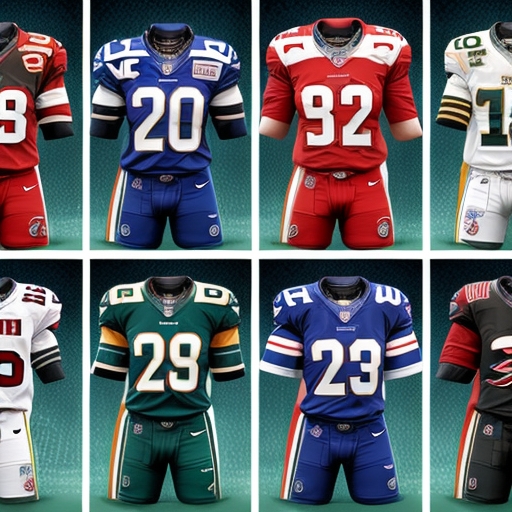
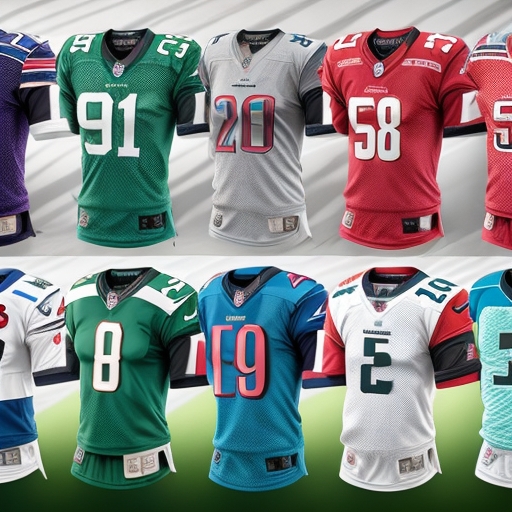
A. Hook: The Cultural Significance of Jerseys in Sports
In the grand amphitheater of sports, jerseys are far more than mere uniforms. They are stitched narratives, woven amalgams of history, pride, and identity. They are sartorial totems that unite fans and athletes alike in a collective spirit, a visual language that transcends spoken dialects. When you don a jersey, you don not just fabric; you don a legacy.
B. The Evolution of NFL Jerseys: From Utility to Identity
The NFL jersey has undergone a metamorphosis since its rudimentary inception. Initially conceived as utilitarian garb to differentiate players in the chaos of the gridiron, these jerseys have evolved into complex tapestries that encapsulate team heritage, regional ethos, and even socio-political stances. From the coarse woolen garments of the early 20th century to today's aerodynamic marvels engineered for optimal performance, NFL jerseys have become cultural artifacts. They are now repositories of stories, each stitch a silent testament to triumphs, tribulations, and traditions.
C. Thesis Statement: Exploring the Impact, Economics, and Aesthetics of NFL Jerseys
This article seeks to unfurl the intricate tapestry that is the NFL jersey. Through an exploration of its historical evolution, the semiotics of its design elements, the economics driving its industry, and its indelible impact on fan culture and beyond, we aim to elucidate why the NFL jersey is far more than a piece of clothing. It is an emblem of community, a commercial juggernaut, and an aesthetic statement, all woven into the fabric of American culture.
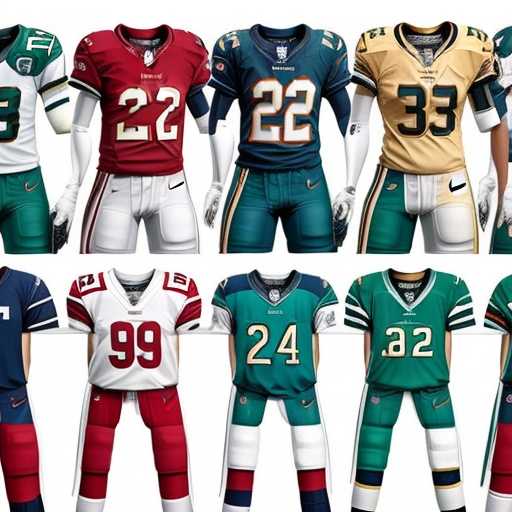
A. The Genesis: Early Days of Football Jerseys
In the nascent stages of American football, the concept of a jersey was far removed from the spectacle we are accustomed to today. Early football jerseys were functionally austere, crafted purely to serve as an identifier among a melee of players. Teams often took the field in simple woolen garments, their colors chosen more for visibility than any deeper symbolic significance. The focus was on practicality; aesthetic considerations were, quite simply, an afterthought. It was an era where the jersey was an implement, not yet an icon.
B. Material Evolution: From Wool to High-tech Fabrics
As football burgeoned into a national pastime, so too did the science of its apparel. Wool gave way to cotton, and eventually to the synthetic marvels we see today—polyester blends engineered for breathability, moisture-wicking, and aerodynamic efficiency. This material evolution wasn't merely a pursuit of comfort or enhanced performance; it was a reflection of technological zeitgeist. The 21st-century jersey is a triumph of engineering, marrying form and function in a symbiotic dance. It's a testament to human ingenuity, where textile science and athletic endeavor meet in harmonious accord.
C. Iconic Jerseys: Milestones That Shaped the Industry
The annals of NFL history are dotted with jerseys that have transcended their utilitarian purpose to become cultural landmarks. Take, for instance, the Pittsburgh Steelers' black and gold ensemble, a nod to the city's industrial heritage, or the Dallas Cowboys' iconic silver and navy, which has become synonymous with American football itself. Then there are the milestone jerseys, like that of New York Jets' Joe Namath, who famously guaranteed a Super Bowl III victory, or San Francisco 49ers' Jerry Rice, who became the epitome of excellence in his red and gold number 80. These jerseys have become more than mere sportswear; they're woven into the cultural and historical lexicon of the nation.
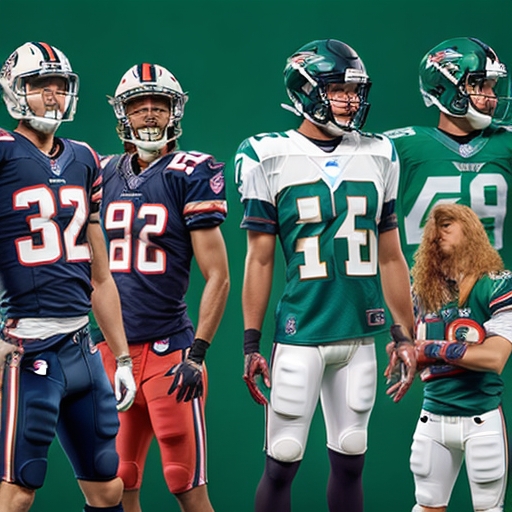
A. Colors and Emblems: The Semiotics of Team Identity
In the lexicon of visual communication, few elements are as potent as color and emblem. Within the NFL, these elements serve as the cornerstone of team identity. The Denver Broncos' orange, for instance, evokes the breathtaking sunsets of the Colorado sky, while the Philadelphia Eagles' green pays homage to the verdant landscapes that define Pennsylvania. Emblems, too, are rife with symbolism: the New England Patriots' minuteman, the Chicago Bears' wishbone 'C,' each serves as a totemic representation of a team's cultural milieu. These visual elements are not arbitrary choices; they are carefully curated narratives, a form of non-verbal storytelling that engenders a sense of belonging among fans and players alike.
B. Typography and Numbering: Subtle Yet Significant
While colors and emblems might capture the eye, it's the subtler design elements like typography and numbering that often capture the soul. The typefaces chosen for player names and numbers may seem inconsequential, but they too bear semiotic weight. Whether it's the blocky, no-nonsense fonts of traditional teams like the Green Bay Packers or the sleek, modernist typography of newer franchises like the Houston Texans, these choices reflect underlying values and aspirations. The numbering, often customized, can also carry individual significance for players, many of whom choose numbers that have personal or historical relevance. In this way, typography and numbering serve as ancillary, yet crucial, elements in the jersey's narrative tapestry.
C. Cultural References: Celebrating Cities, Tributes, and Social Causes
Increasingly, NFL jerseys have become a canvas for broader cultural expressions. Some jerseys feature design elements that celebrate the cities they represent; the New Orleans Saints' fleur-de-lis is a tribute to the city's French heritage, for example. Others serve as vehicles for social commentary or tributes: think of the Washington Football Team’s transformation in response to criticisms of cultural insensitivity, or the "Salute to Service" jerseys that honor military personnel. In recent years, teams have even donned jerseys that support social causes, turning them into wearable manifestos that extend their relevance beyond the football field.
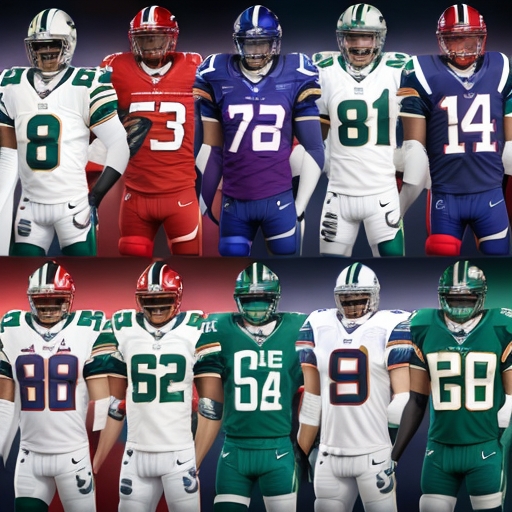
A. The Business Model: Licensing and Merchandising
At the core of the NFL jersey industry lies a sophisticated business model anchored in licensing and merchandising agreements. The NFL, a behemoth of sports entertainment, licenses its brand and team logos to apparel companies, most notably Nike, in multi-year deals worth billions. In return, these companies gain the exclusive right to manufacture and distribute official NFL jerseys, a privilege that comes with stringent quality controls and marketing stipulations. The revenue generated is not merely pocket change; it's a significant income stream that is shared among the teams and contributes to the league's financial health. This symbiotic relationship between the NFL and apparel companies is the linchpin that holds the jersey economy together.
B. Market Dynamics: The Best-selling Jerseys and Why
Understanding the market dynamics of NFL jerseys requires delving into the labyrinthine psychology of consumer behavior. Factors like team performance, player popularity, and even sociopolitical stances can dramatically influence sales. For instance, a rookie sensation can catapult jersey sales overnight, while a veteran's retirement can turn a regular jersey into a nostalgic keepsake. Special editions, such as "Color Rush" or championship commemoratives, can also spike demand. Unpacking the best-selling jerseys is like peering into a cultural kaleidoscope, reflecting the multifaceted tastes and loyalties of the NFL's expansive fan base.
C. The Secondary Market: Collectibles and Vintage Jerseys
Beyond the glitzy storefronts and official online shops lies a thriving secondary market for NFL jerseys. This subterranean economy is a treasure trove of vintage jerseys, limited editions, and rare collectibles. Auction houses, online platforms, and even dedicated fan forums serve as conduits for transactions that can sometimes fetch astronomical sums. The allure of these jerseys often lies in their historical significance or sentimental value; a game-worn jersey from a Super Bowl legend can become a sacred relic. This secondary market not only adds another layer to the economics of NFL jerseys but also elevates them into the realm of cultural artifacts worth preserving and collecting.
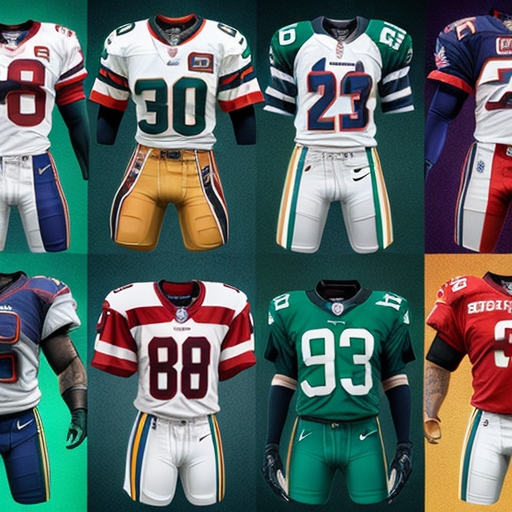
A. Material Innovation: Breathability, Durability, and Comfort
The modern NFL jersey is a marvel of textile engineering, a far cry from its humble, woolen predecessors. Today's materials prioritize breathability, allowing for efficient thermal regulation and moisture-wicking during the rigors of the game. Durability is another key attribute, given the physical exigencies of football; contemporary fabrics are designed to withstand intense stretching, tearing, and weather conditions. Comfort, too, is of paramount importance, with ergonomic designs and lightweight materials that enhance player mobility. In this realm, innovation is ceaseless, driven by a quest to create the optimal second skin for athletes.
B. Smart Jerseys: The Intersection of Fashion and Technology
As we venture into the realm of smart textiles, NFL jerseys are beginning to incorporate features that transcend aesthetic and functional purposes. Imagine a jersey that not only absorbs sweat but also measures physiological data like heart rate, temperature, and muscle strain. While still largely in the experimental phase, these 'smart jerseys' represent the future convergence of fashion, technology, and sports science. It's an exciting frontier, one that promises to redefine the fan experience by offering interactive elements like real-time stats and even augmented reality features.
C. Environmental Sustainability: Eco-friendly Materials and Practices
In an era increasingly defined by environmental consciousness, the NFL and its apparel partners are making strides in sustainable practices. From utilizing recycled materials to adopting water-efficient dyeing techniques, eco-friendly initiatives are becoming integral to the jersey manufacturing process. Certain teams have even released special 'green' editions of their jerseys, made entirely from sustainable fabrics. These endeavors not only reflect a broader societal shift towards sustainability but also signal the league's commitment to being stewards of the planet.
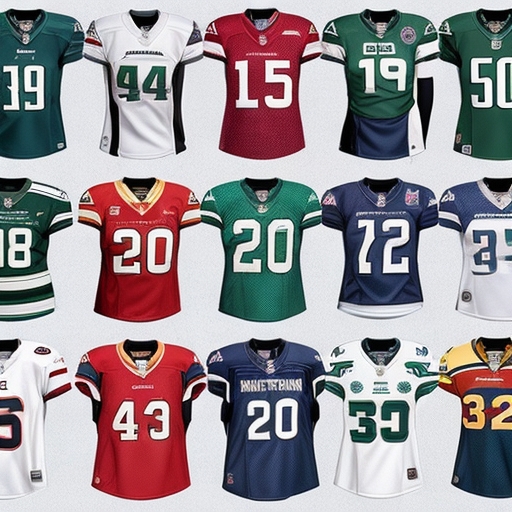
A. Jerseys as Social Signifiers: The Psychology of "Wearing Your Team"
In the psychological theater of sports fandom, jerseys serve as powerful social signifiers. Donning a team's jersey is akin to hoisting its flag, a public declaration of allegiance and identity. Fans wear jerseys not just to games, but to social gatherings, work, and even casual outings, transforming them into walking billboards of loyalty and pride. This sartorial choice often engenders a sense of communal belonging, forging an unspoken kinship among strangers who share the same colors. The psychology here is profound: the act of wearing a jersey taps into our intrinsic need for community and validation, making it a potent tool for social bonding.
B. Fandom and Fashion: The Rise of Casual and Custom Jerseys
As NFL jerseys have infiltrated mainstream fashion, a fascinating trend has emerged: the rise of casual and custom jerseys. No longer confined to game days or sports bars, these jerseys are being styled with everyday outfits, blurring the lines between sportswear and streetwear. The market has also seen a surge in customized jerseys, where fans can imprint their names or preferred numbers, thereby making a personal statement. Some fans even opt for jerseys that reflect special occasions, like anniversaries or milestones, adding another layer of personal significance to the garment. This intersection of fandom and fashion broadens the relevance of NFL jerseys, positioning them as versatile apparel for various social contexts.
C. Global Reach: How NFL Jerseys Have Become Global Icons
The allure of NFL jerseys extends beyond the borders of the United States, capturing imaginations across the globe. From London to Tokyo, fans sport the colors of teams they've never seen play in person, a testament to the league's international appeal. Special international games, like those in the NFL London Series, often result in limited-edition jerseys that become instant global collectibles. Moreover, the rise of online streaming and social media has amplified the reach of the NFL, turning jerseys into global icons of American culture. They serve as a universal language of sorts, breaking down geographical barriers and uniting fans worldwide in a shared passion.
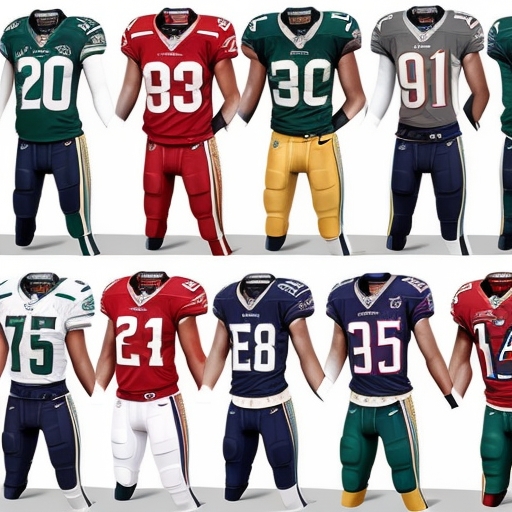
A. Cultural Appropriation: The Controversy of Native American Imagery
In recent years, the NFL has faced heightened scrutiny over the use of Native American imagery in team logos and jerseys. Teams like the Washington Football Team have undergone rebranding to address the criticisms of cultural appropriation and insensitive stereotyping. These controversies have sparked a broader debate about the ethical responsibility of sports organizations to respect cultural identities, especially when such imagery is commodified through jersey sales. It's an ongoing discourse, one that has forced the NFL to confront uncomfortable historical legacies and pave the way for more inclusive representation.
B. Fair Trade: Labor Practices in Jersey Manufacturing
As with any mass-produced consumer good, the specter of labor ethics looms large over the NFL jersey industry. Questions arise about the conditions under which these jerseys are manufactured, including wage fairness, worker safety, and environmental impact. Brands like Nike have taken steps to improve transparency and adhere to fair trade practices, but the issue remains a focal point of ethical scrutiny. It's a complex challenge that involves multiple stakeholders—from league executives to apparel partners and even consumers—who must collectively strive for ethical integrity in the production process.
C. Authenticity vs. Counterfeits: The Ethical Dilemma
The popularity of NFL jerseys has given rise to a thriving counterfeit market, offering fans cheaper alternatives to official merchandise. While these knock-offs may seem like harmless bargains, they present an ethical quandary. Counterfeit jerseys often bypass quality controls and labor regulations, not to mention they infringe upon intellectual property rights. The dilemma extends to consumers, who must grapple with the ethical implications of their purchasing choices. It's a contentious issue that pits the allure of affordability against the principles of authenticity and ethical commerce.
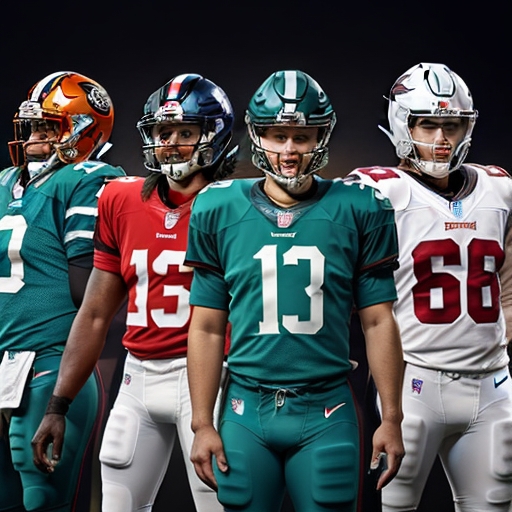
A. The '72 Dolphins: A Lesson in Timelessness
The 1972 Miami Dolphins hold the distinction of being the only NFL team to complete a perfect season, culminating in a Super Bowl victory. The aqua and coral jerseys they wore have become emblematic of excellence and timelessness. Even today, these jerseys are sought after by collectors and fans, not just for their aesthetic appeal but for what they symbolize—a pinnacle of athletic achievement. The longevity of these jerseys in popular culture showcases how an extraordinary on-field performance can immortalize a piece of sportswear, transforming it into a timeless artifact.
B. Colin Kaepernick: A Jersey as Political Statement
The jersey of Colin Kaepernick, the former San Francisco 49ers quarterback, has evolved into something far more potent than a mere sports uniform. Following his decision to kneel during the national anthem as a protest against racial injustice, Kaepernick's jersey became a symbol of political activism. Sales skyrocketed, and the jersey was donned not just by football fans but by individuals aligning with the broader social justice movement. This case illuminates how an NFL jersey can serve as a canvas for political expression, amplifying voices and causes that extend far beyond the gridiron.
C. The 'Color Rush': A Marketing Phenomenon
Introduced in 2015, the NFL's 'Color Rush' jerseys represent a masterstroke in sports marketing. These jerseys, characterized by monochromatic color schemes, were initially unveiled for Thursday Night Football but quickly gained popularity for their bold aesthetics. Not only did they breathe fresh life into traditional team colors, but they also created a frenzy of consumer demand, becoming hot-ticket items almost overnight. The 'Color Rush' serves as an illustrative example of how clever marketing can not only rejuvenate interest in team apparel but also create a cultural moment that captivates fans and casual viewers alike.
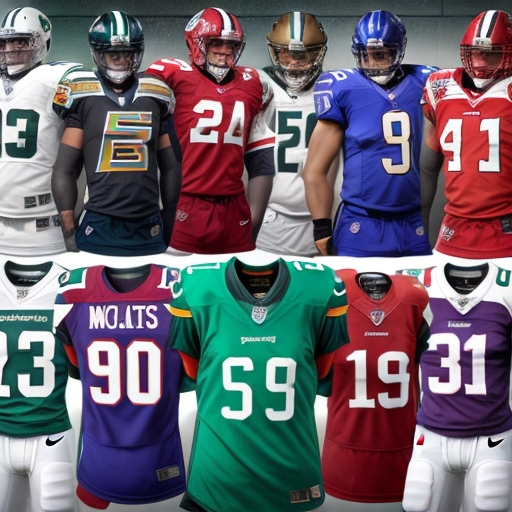
A. Summary of Key Insights
Our journey through the multifaceted world of NFL jerseys has revealed them to be far more than mere athletic wear. They are historical artifacts that chart the evolution of both the sport and the society in which it exists. They are complex symbols loaded with semiotic nuance, from team colors to typography. Economically, they are both products and producers of a vast commercial ecosystem, one that extends its tendrils from licensing deals to global markets. Technologically, they are at the cutting edge, continually redefining what sportswear can be. Ethically, they engage us in dialogues about cultural sensitivity, fair labor, and consumer responsibility. Finally, through various case studies, we've seen how individual jerseys can become icons of cultural, political, or commercial import.
B. The Future of NFL Jerseys: Predictive Musings
As we look to the future, it's conceivable that NFL jerseys will continue to evolve in ways that reflect broader trends in technology, fashion, and social awareness. Smart textiles could make the leap from experimental curiosities to standard features, providing real-time biometric data or enhanced fan interactivity. Sustainability will likely become a cornerstone, not an afterthought, in jersey production. Customization could reach new heights, allowing fans unprecedented freedom to personalize their jerseys, thereby blurring the lines between consumer and creator.
C. Final Thoughts: The Jersey as More Than Just Apparel
In the final analysis, an NFL jersey is more than a garment; it's a narrative tapestry woven from threads of history, culture, innovation, and human emotion. To wear a jersey is to align oneself with a story, to become a chapter in an ongoing saga that transcends sport. Whether you're a player on the field, a fan in the stands, or a casual observer, when you put on that jersey, you're not just representing a team—you're embodying a complex amalgamation of values, aspirations, and communal identity.